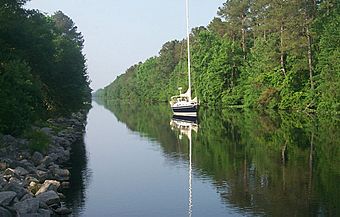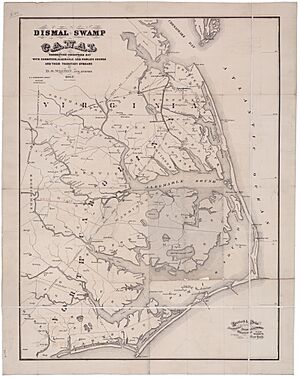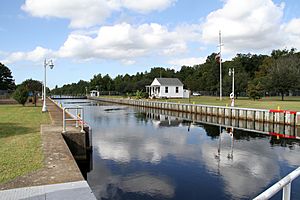Dismal Swamp Canal facts for kids
|
Dismal Swamp Canal
|
|

A sailboat on the Dismal Swamp Canal
|
|
| Location | Runs between Chesapeake, Virginia, and South Mills, North Carolina |
|---|---|
| Area | 1,203 acres (487 ha) |
| Built | 1793 |
| Architect | Dismal Swamp Canal Co.; US Army Corps of Engineers |
| MPS | Dismal Swamp Canal and Associated Development, Southeast Virginia and Northeast North Carolina MPS |
| NRHP reference No. | 88000528 |
Quick facts for kids Significant dates |
|
| Added to NRHP | June 06, 1988 |
The Dismal Swamp Canal is a very old waterway in the United States. It runs along the eastern edge of the Great Dismal Swamp in Virginia and North Carolina. This canal is special because it's the oldest man-made canal in the U.S. that's still being used today. It first opened in 1805. The canal is also part of a larger water route called the Intracoastal Waterway.
Building the Canal
Long ago, during the time of the American colonies, water travel was very important. It was how people moved goods and traveled in areas like the North Carolina sounds and Virginia's Tidewater region. These areas needed a better way to connect to bigger markets like Norfolk, Virginia. Land travel was difficult, and the ocean coast was dangerous.
In 1763, George Washington visited the Great Dismal Swamp. He thought it would be a good idea to dig a canal through it. This canal would connect the Chesapeake Bay in Virginia with the Albemarle Sound in North Carolina. Later, as the first president, Washington supported building canals. He believed they were the best way to move things around inside the country.
In 1784, the Dismal Swamp Canal Company was formed. Work on the canal started in 1793. The canal was dug entirely by hand. Most of the hard work was done by enslaved people. They were hired from nearby landowners. It took about 12 years to finish the 22-mile-long canal. It finally opened in 1805.
Around the time the canal opened, a hotel was built right on the state line. It was called the Dismal Swamp Hotel. This hotel was popular with people who wanted to gamble. If the sheriff from one state arrived, gamblers could just move their game to the other side of the room, which was in a different state! Today, there is no sign of the hotel left.
People had to pay tolls to use the canal. These fees helped pay for its upkeep and improvements. In 1829, the canal was made deeper. Before railroads and highways became common, the canal was a very important way to transport goods.
The Canal During the Civil War
During the American Civil War (1861–1865), the canal was very important for both the Union and Confederate armies. In April 1862, the Union army heard that the Confederates might use the canal. They thought the Confederate ironclad ship might try to escape through it.
Union General Ambrose Burnside sent troops to destroy the Culpepper Locks. These locks were near South Mills, North Carolina on the canal. On April 18, about 3,000 Union soldiers landed near Elizabeth City, North Carolina.
The next morning, the Union troops marched towards South Mills. Confederate Colonel Ambrose R. Wright had about 900 men waiting for them. The two sides fought for four hours. The Confederates eventually had to retreat. General Reno's Union troops were tired and had lost many soldiers. He decided not to chase them. That night, he heard more Confederate soldiers were coming. So, he ordered his troops to quietly march back to their ships. About 114 Union soldiers and 25 Confederate soldiers were lost in this fight.
This battle, called the Battle of South Mills, was the only major fighting near the canal. However, the war left the canal in bad shape. It was hard to travel through it because of the damage.
After the War: The 1900s
In 1892, a company called Lake Drummond Canal and Water Company started fixing up the canal. Soon, many boats were using it again. They carried lumber, farm products, and even passengers. The canal became a busy route between states.
By the 1920s, other ways of travel, like cars and trucks, became more popular. This meant fewer commercial boats used the canal. In 1929, the U.S. government bought the canal for $500,000.
Later, in the mid-1900s, recreational boating became popular. The canal became an important route for pleasure boats. It offered a safe path away from the rough waters of the Atlantic Ocean.
The Canal Today
Today, the United States Army Corps of Engineers takes care of the Dismal Swamp Canal. It is one of two inland routes that connect the Chesapeake Bay and the Albemarle Sound. About 2,000 recreational boaters use the canal each year. They travel through it as part of the Intracoastal Waterway.
In October 2016, the canal had to close to boats. A big storm, Hurricane Matthew, caused a flash flood. This flood filled the canal with dirt and sand, making it too shallow. It was dredged (cleaned out) in November 2017 to make it deep enough again. It reopened for a short time. However, it closed again because of too much duckweed. Duckweed is a small plant that can clog boat engines. As of March 2018, the canal has reopened.
The northern part of the canal is in Chesapeake, Virginia. It connects to the Southern Branch Elizabeth River. The southern end of the canal leads to the Albemarle Sound.
The Dismal Swamp Canal Visitor Center is a unique place. It is the only visitor center in the U.S. that greets visitors from both a major highway and a historic waterway. You can find it in Camden County, North Carolina, on U.S. Highway 17.
The canal is listed on the National Register of Historic Places. It has also been named a National Civil Engineering Landmark. This historic canal is now recognized as part of the Underground Railroad. Along with the Great Dismal Swamp, it was a safe place for enslaved people seeking freedom.
The East Coast Greenway is a very long trail system. It connects Maine to Florida. Part of this 3,000-mile trail runs along the Dismal Swamp Canal Trail.
Boaters visiting the swamp in the fall need to watch out for duckweed. It can cover the canal like a carpet. This can cause problems for boat engines.








